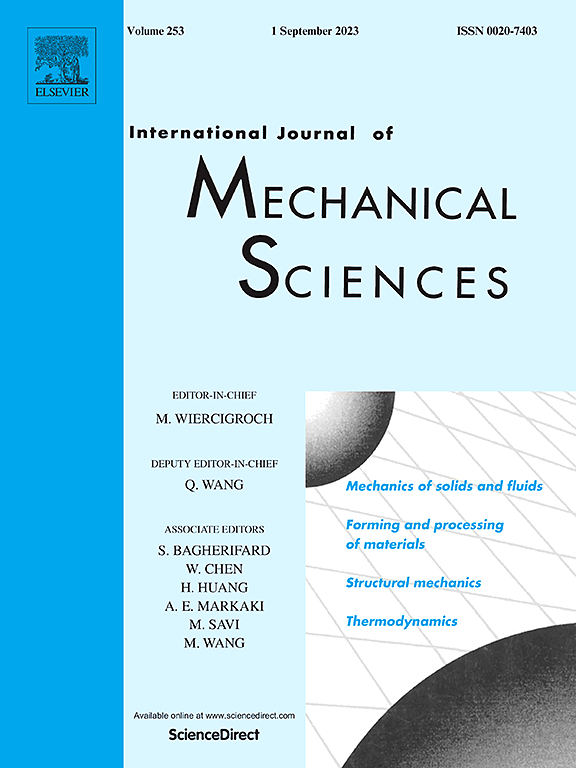基于有限元分析的斜钻砧优化
IF 7.1
1区 工程技术
Q1 ENGINEERING, MECHANICAL
International Journal of Mechanical Sciences
Pub Date : 2025-07-12
DOI:10.1016/j.ijmecsci.2025.110602
引用次数: 0
摘要
金刚石砧细胞(DAC)是高压研究中的关键工具,可以探索极端条件下的材料行为。然而,要实现超过当前极限的压力,就必须优化金刚石砧的几何结构。为了解决这一挑战,我们开发了一个四阶应变能函数来捕捉DAC操作过程中金刚石的各向异性、非线性和大弹性变形。此外,引入有限应变弹性失稳判据,确定了金刚石砧在缺陷成核开始时的临界形态。基于这一新的计算框架,进行了有限元分析,分析了切削齿直径、摩擦系数、斜角和斜角直径对金刚石顶砧性能的影响。随后导出了一个经验方程,定量地将机械性能与斜角金刚石砧的几何结构联系起来。开发的框架能够可靠地模拟和预测金刚石顶砧的性能,特别是对于直径约为20 μm的顶砧,这是一个关键但在实验上具有挑战性的制度,通常被认为是超越当前压力限制的关键。这项工作不仅促进了对金刚石砧力学的基本理解,而且为指导下一代超高压实验DAC配置的设计提供了一个强大的工具。本文章由计算机程序翻译,如有差异,请以英文原文为准。

Optimizing beveled diamond anvils via finite element analysis
Diamond anvil cell (DAC) is a pivotal tool in high-pressure research, enabling the exploration of material behaviors under extreme conditions. However, achieving pressures beyond the current limits necessitates optimizing the geometric configuration of diamond anvil. To address this challenge, we developed a fourth-order strain energy function to capture the anisotropic, nonlinear, and large elastic deformations of diamond during DAC operation. In addition, an elastic instability criterion at finite strain was incorporated to identify the critical configuration of diamond anvils at the onset of defect nucleation. Based on this novel computational framework, finite element analysis (FEA) was conducted to evaluate how culet diameter, friction coefficient, bevel angle, and bevel diameter influence the performance of diamond anvils. An empirical equation was subsequently derived to quantitatively link the mechanical performance to the geometric configuration of beveled diamond anvils. The developed framework enables reliable simulation and prediction of diamond anvil performance, particularly for anvils with culet sizes around 20 μm, a critical yet experimentally challenging regime often regarded as key to surpassing current pressure limits. This work not only advances the fundamental understanding of diamond anvil mechanics but also provides a robust tool to guide the design of next-generation DAC configurations for ultra-high-pressure experiments.
求助全文
通过发布文献求助,成功后即可免费获取论文全文。
去求助
来源期刊

International Journal of Mechanical Sciences
工程技术-工程:机械
CiteScore
12.80
自引率
17.80%
发文量
769
审稿时长
19 days
期刊介绍:
The International Journal of Mechanical Sciences (IJMS) serves as a global platform for the publication and dissemination of original research that contributes to a deeper scientific understanding of the fundamental disciplines within mechanical, civil, and material engineering.
The primary focus of IJMS is to showcase innovative and ground-breaking work that utilizes analytical and computational modeling techniques, such as Finite Element Method (FEM), Boundary Element Method (BEM), and mesh-free methods, among others. These modeling methods are applied to diverse fields including rigid-body mechanics (e.g., dynamics, vibration, stability), structural mechanics, metal forming, advanced materials (e.g., metals, composites, cellular, smart) behavior and applications, impact mechanics, strain localization, and other nonlinear effects (e.g., large deflections, plasticity, fracture).
Additionally, IJMS covers the realms of fluid mechanics (both external and internal flows), tribology, thermodynamics, and materials processing. These subjects collectively form the core of the journal's content.
In summary, IJMS provides a prestigious platform for researchers to present their original contributions, shedding light on analytical and computational modeling methods in various areas of mechanical engineering, as well as exploring the behavior and application of advanced materials, fluid mechanics, thermodynamics, and materials processing.
 求助内容:
求助内容: 应助结果提醒方式:
应助结果提醒方式:


